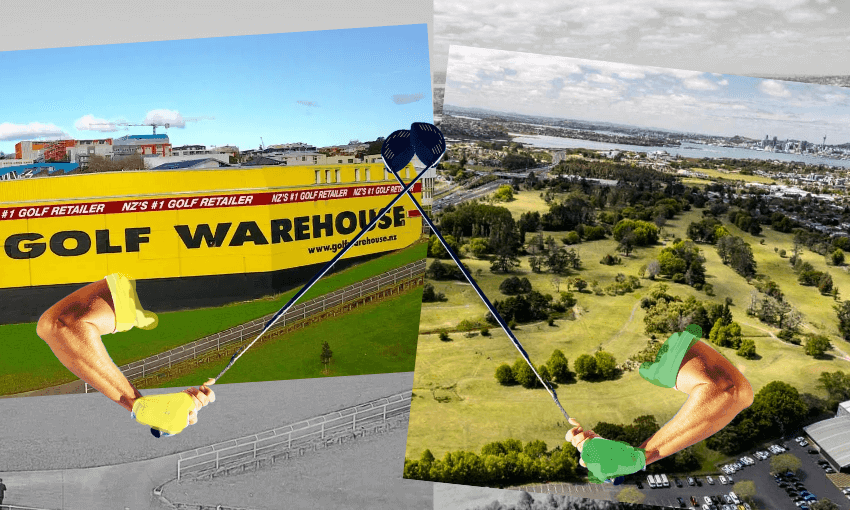The battle over the future of Takapuna Golf Course has been pitched as golfers vs the council. But a rival golf superpower thinks it’s come up with a way to keep everyone happy.
Eric Faesenklout and I should be mortal enemies. The 71-year-old Takapuna resident thinks the problem with the media is it’s gone too far left. As chairman of Golf Warehouse, he’s spent his career aiding and abetting a sport which I once got a professional economist to define as “bullshit”. Moreover, he’s responsible for the huge yellow cuboid structure which taunts me from its perch atop Newton Road as I shiver my way to The Spinoff offices on my woke e-scooter.
But some bonds run deeper than a dispute over colour schemes, and Faesenklout and I are aligned where it counts: on the need to reduce the size and scope of Takapuna Golf Course. Right now the course’s fate hangs in the balance. The council wants to turn a large portion of the public park it sits on into a wetland, citing its preference for people to “not die” in a repeat of the Auckland Anniversary weekend floods.
Course operators have responded with an ambitious, some would say improbable, plan to keep 18 holes and still store 550 million litres of potential floodwater. They’ve been backed by a gaggle of supporters, including one labrador who’s been threatened with a lifetime of hoovering up duck droppings if the wetland gets built.
Golf Warehouse wants to occupy the middle ground. It’ll let the council plop down all the duck poo it wants in exchange for a lease allowing Gold Warehouse to build a nine-hole golf course, two mini-golf courses, a driving range, a three-par family course and a restaurant on the remaining land. Its proposal started taking shape a few years ago, when Faesenklout heard the course operators’ lease was about to end. His company spent thousands coming up with concepts. The proposal is personal. It would serve the area where Faesenklout has lived for 40 years. “I’m 71,” he tells me, in a sashimi-fuelled interview at Tokyo Bay on the Takapuna beachfront. “We’d like to leave something outstanding to the community and at the same time run a commercial business.”
The course’s lease has now expired, and Faesenklout is bewildered at the lack of interest in his proposal. He’s tried, unsuccessfully, to pitch to Kaipātiki Local Board members charged with deciding on the course’s lease. He’s struggled to get council officials on the line. That’s frustrating because, as he sees it, Golf Warehouse is kind of a big deal. It controls around half the country’s market share in golf retail, and operates busy driving ranges and nine-hole facilities across Auckland. The irritation got to him at a recent meeting on the future of the golf course at Eventfinda Stadium, where he stood up and told the complaining crowd they were forgetting a potential alternative that could direct more rent to the council while keeping everyone happy. “We’re trying to do it the proper way but we’ve fallen off deaf ears,” Faesenklout says. “But I still think it’s the best solution for both safety and golf.”
People might start listening soon. The council is set to reveal its decision on the future of Takapuna Golf Course later this morning. It’s likely to say it’s impossible to retain all 18 holes while still providing enough stormwater detention for a future flood. That’ll annoy golfers. But any delay to the flood prevention measures will be equally vexing to the Wairau Valley locals who don’t want to lose their houses, businesses or lives when the next large low pressure system parks itself over the area. Politicians will be looking for a solution that stops them getting pelted with duck poo or nine irons during the upcoming local election campaign.
Before the interview ends, I ask Faesenklout about the yellow warehouse on Newton Road. “You should’ve seen what was there before,” he says. “It used to be a bright red building.” Red, the colour of anger and blood. Faesenklout says he’s given the place a happier, more people-pleasing aspect, at least compared to what was there previously. I have to admit they’ve created a landmark. Maybe it’s not always perfectly suited to my tastes, but sometimes a compromise option can be good for everyone.





